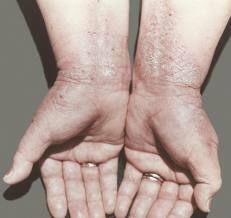Allergy to hair dye
 Allergy to hair dye - an acute allergic reaction of the body to the components that make up all hair dyes. In recent years, this type of allergic reaction is very common. Despite the fact that they usually write on all packages: "the paint does not cause allergy", or "hypoallergenic paint", the allergy still overtakes, as usually all these inscriptions are an ordinary advertising move that raises sales of this product. The same kind of hair dye for some women will not cause any reactions, while others will turn out to be very painful consequences. That is why, in the case of even full confidence in the absolute harmlessness of the chosen paint, you should first conduct an allergy test.
Allergy to hair dye - an acute allergic reaction of the body to the components that make up all hair dyes. In recent years, this type of allergic reaction is very common. Despite the fact that they usually write on all packages: "the paint does not cause allergy", or "hypoallergenic paint", the allergy still overtakes, as usually all these inscriptions are an ordinary advertising move that raises sales of this product. The same kind of hair dye for some women will not cause any reactions, while others will turn out to be very painful consequences. That is why, in the case of even full confidence in the absolute harmlessness of the chosen paint, you should first conduct an allergy test.
The test that determines a possible allergic reaction to hair dye is as follows. It is necessary to take an insignificant amount of paint prepared for further use and apply for a period of not less than a few days on a small area of the skin. Most often for this purpose, women use the elbow bend. In the case of a known irritation of the skin after the specified period, it can be confidently asserted that the chosen paint for further use for its intended purpose is not suitable. With a new paint is also necessary to conduct a similar test.
The most allergenic substance that forms part of almost all hair colors is the paraphenylenediamine used for persistent staining. Colors that do not contain this component are very rare, the color lasts not so long, and they cost an order of magnitude more. In some European countries( Sweden, France, Germany), paraphenylenediamine is completely banned, or it is allowed in the maximum permissible concentration of not more than six percent. The most common allergy to hair dye is observed in women who choose darker colors for staining, since in light dyes the proportion of paraphenylenediamine does not exceed two percent.
In addition to allergic reaction, such substances as Isatin, 6-hydroxyindole, and p-Methylaminophenol
can cause an allergic reaction. Hair color allergy - symptoms of
In most cases, the allergy to hair dye is manifested by dermatitis along the hair and face lines. In the case of a severe reaction, swelling of the entire face can be observed.
The most common reactions that develop when allergic to hair dye:
• Contact urticaria. This condition manifests itself as reddish scaly, flaky spots throughout the body, difficulty in swallowing, wheezing, sneezing, swelling of the eyelids. Symptomatology can develop both instantaneously and after a few hours of
• Contact dermatitis. It appears scaly itchy red spots on the skin, which usually appear in the line of hair growth, on the tips of the ears and eyelids. As the disease progresses, contact dermatitis can spread to other areas of the face, neck and hands. Usually, this symptomatology lasts no more than ten days, after which even without treatment passes, but if dermatitis is not treated, then with repeated use of a provoking dye it will appear again
• Anaphylactic shock. This reaction to hair dye is the most dangerous, however, fortunately, it is observed in isolated cases. Anaphylactic shock creates a real threat to life and is manifested by a sharp decrease in blood pressure, dyspnea, asphyxia, edema of the face, etc. In case of failure to provide emergency medical care, a fatal outcome is possible.
Hair color allergy - treatment
What to do if an allergy to hair dye develops? First of all, it should be immediately washed off and rub the affected skin with chamomile lotion. It is known that it is the camomile has excellent anti-inflammatory properties and as an emergency aid will do the best. Also, for an early withdrawal of toxins from the body, an abundant drink is recommended.
If, after a day, allergic manifestations have not disappeared, you should not hesitate to apply for a qualified honey. Help to a dermatologist or an allergist who, after identifying a provoking allergen, is likely to be prescribed antihistamines used to treat allergic reactions. To remove the edema, usually apply corticosteroids and cortisone creams.
In some cases, the allergic reaction to paraphenylenediamine is laid down at the genetic level, so if this is confirmed, it is better to refuse hair colors altogether, or to use natural dyes for staining. Before the beginning of dyeing it is necessary to check the skin of the head for any damage, Even the slightest scratch or scratch significantly increases the risk of developing an allergy to hair dye.
In addition, it is desirable to dye the hair in the beauty salon, because there it will do much more carefully and professional hair colors are less aggressive in their composition.
Alternatively, bezammia paints can be used to color the hair, but even they can cause allergy development due to the presence of hydrogen peroxide in them, although it is there in low concentration.
Below we want to bring three recipes for natural hair dyes, which though not able to change the color of hair radically, but to give the desired shade will be able to:
• For giving a chestnut shade, you can use the following broth: in 200 ml of boiled water brew 3 tablespoonsTea + 1 tsp soluble coffee + 1 tsp cocoa powder
• Blondes for giving a golden hue is recommended to use a decoction of onion husks: 200 ml of boiling water 2 handfuls of husk. Also for these purposes you can use a decoction of chamomile: for 500 ml of water 1 tbsp. Spoon of rhizomes of nettle + 1 tbsp. Spoon of chamomile flowers
• The most famous natural hair dyes are basma and henna. They are also good because they can be planted not only with ordinary water, but also with red wine, as well as kefir, to give the desired shade.



